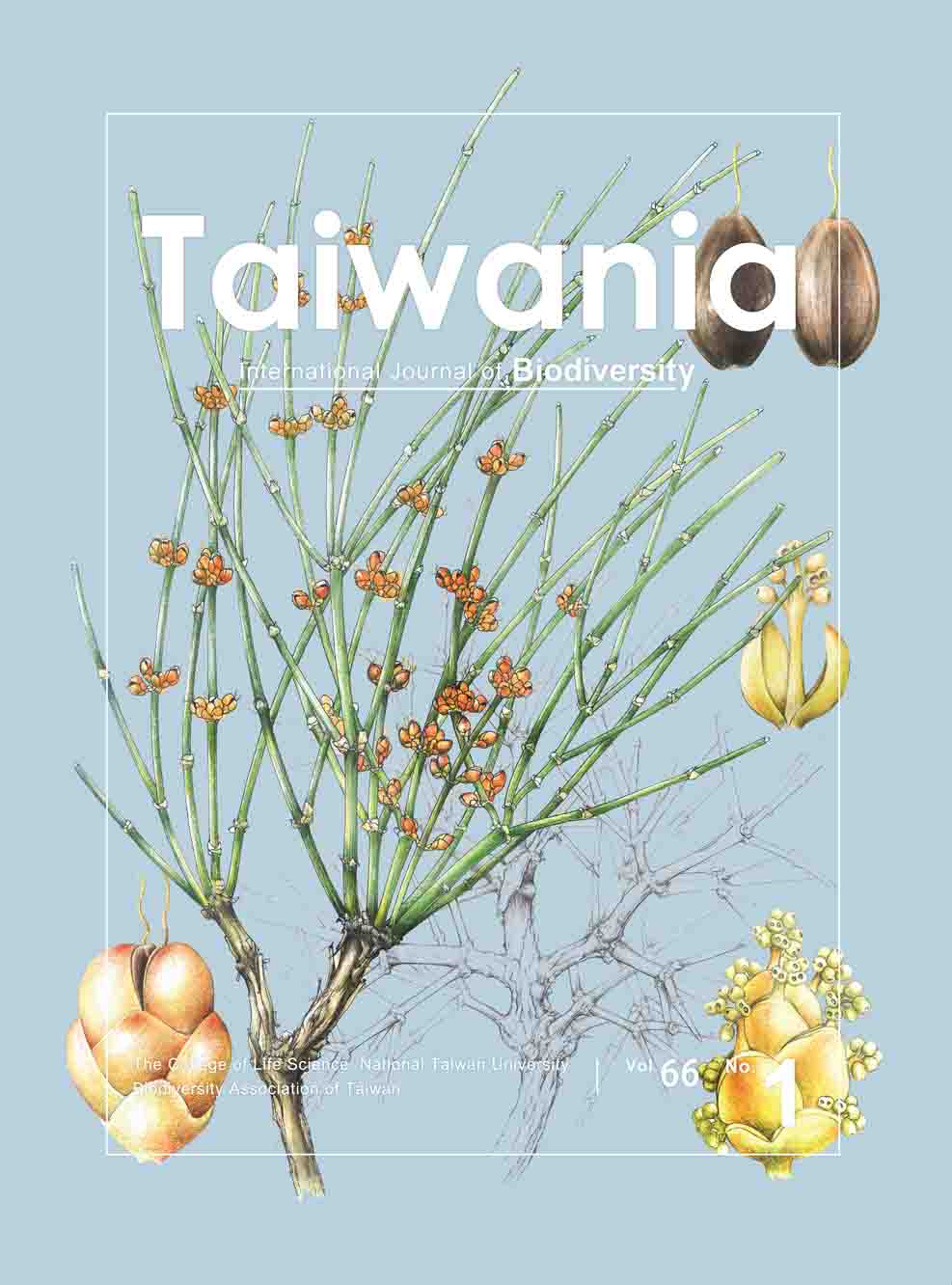Research Paper
Myriospora himalayensis (Acarosporaceae, lichenized fungi), a new species from Western Himalayan region of India
Gaurav K. Mishra, Sanjeeva Nayaka, Dalip K. Upreti
Published on: 03 March 2021
Page: 89 - 92
DOI: 10.6165/tai.2021.66.89
Abstract
Myriospora himalayensis is described as a new to science. The new species is characterized by having pruinose apothecia with small (1.5–2.5 × 1–1.2 µm), hyaline, ellipsoid ascospores and areolate-effigurate to squamulose-lobate thalli with grey to brownish upper surface. The new species is so far known only from the Western Himalayan region of India. A key to all known species of Myriospora from the world is provided.
Keyword: Acarospora, Ascomycota, biodiversity, key, lichenized fungi, Myriospora myochroa, taxonomy
Literature Cited
Arcadia, L. and K. Knudsen. 2012. The name Myriospora is available for the Acarospora smaragdula group. Opusc. Philolichenum 11: 19–25.
Awasthi, D.D. 2007. A compendium of the Macrolichens from the India, Nepal and Sri Lanka. Bishen Singh and Mahendra Pal Singh, Publishers Dehradun, India.
Crewe, A.T., O.W. Purvis and M. Wedin. 2006. Molecular phylogeny of Acarosporaceae (Ascomycota) with focus on the proposed genus Polysporinopsis. Mycol. Res. 110(5): 521–526.
DOI: 10.1016/j.mycres.2006.01.010View Article
Google Scholar
Harris, R.C. 2004. A preliminary list of the lichens of New York. Opusc. Philolichenum 1: 55–73.
Harris, R.C. and K. Knudsen. 2006. The genus Myriospora. Opusc. Philolichenum 3: 1–4.
Hepp, P. 1853. Abildungen und Beschreibungen der Sporen zum i. ii. Iii. iv. Z?rich.
Knudsen, K. and H. Fox. 2011. Acarospora benedarensis: a rare terricolous maritime lichen from Ireland, Scotland and Wales. Opusc. Philolichenum 9: 31–34.
Knudsen, K. and F. Bungartz. 2014. Myriospora westbergii (Acarosporaceae), a new discovery from the Galapagos Islands, Ecuador. Opusc. Philolichenum 13: 177–183.
Knudsen, K., A. Flakus and M. Kukwa 2012. A contribution to the study of Acarosporaceae in South America. The Lichenologist 44(2): 253–262.
DOI: 10.1017/S0024282911000703View Article
Google Scholar
Knudsen, K. 2007. Acarospora smaragdula in North America. Evansia 24(4): 94–96.
DOI: 10.1639/0747-9859-24.4.94View Article
Google Scholar
Knudsen, K. 2011. A new member of the genus Silobia (Acarosporaceae) from North America. Opusc. Philolichenum 9: 27–30.
Knudsen, K., J. Kocourkova and U. Schiefelbein. 2017. New reports of Myriospora (Acarosporaceae) from Europe. Mycotaxon 132(4): 857–865.
DOI: 10.5248/132.857View Article
Google Scholar
Mishra, G.K. and D.K. Upreti. 2015. Lichens flora of Kumaun Himalaya. LAP LAMBERT Academic Publishing, OmniScriptum GmbH & Co. KG, Heinrich- B?cking-str. 6–8, 66121, Saarbr?cken, Germany.
Orange, A., P.W. James and F.J. White. 2001. Microchemical methods for the identification of lichens. British Lichen Society.
Purvis, O.W., S. Fern?ndez-Brime, M. Westberg and M. Wedin. 2018. Myriospora, a genus newly reported for Antarctica with a worldwide key to the species. The Lichenologist 50(1): 101–112.
DOI: 10.1017/S0024282917000652View Article
Google Scholar
Roux, C. 2014. Catalogue des Lichens et Champignons Lich?nicoles de France M?tropolitaine. Foug?res: Henry des Abbayes.
Roux, V.C., S. Poumarat, C. Gueidan, P.N. Rosines, J.Y. Monnat and K.J.M. Houmeau. 2019. La Acarosporaceae de Okcidenta E?ropo. Bull. Soc. Linn. Provence 70: 219.
Uloth, W. 1861. Beitr?ge zur Flora der Laubmoose und Flechten von Kurhessen. Flora 44: 161–175, 177–187, 565–576, 585–592, 598–607, 617–622, 649–656, 713–716, 735–736, 745–752, 761–763.
Wedin, M., M. Westberg, A.T. Crewe, A. Tehler and O.W. Purvis. 2009. Species delimitation and evolution of metal bioaccumulation in the lichenized Acarospora smaragdula (Ascomycota, Fungi) complex. Cladistics 25(2): 161–172.
DOI: 10.1111/j.1096-0031.2009.00240.xView Article
Google Scholar
Westberg, M, A.T. Crewe, O.W. Purvis and M. Wedin. 2011. Silobia, a new genus for the Acarospora smaragdula complex (Ascomycota, Acarosporales) and a revision of the group in Sweden. The Lichenologist 43(1): 7–25.
DOI: 10.1017/S0024282910000617View Article
Google Scholar


